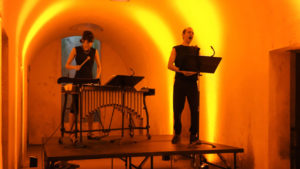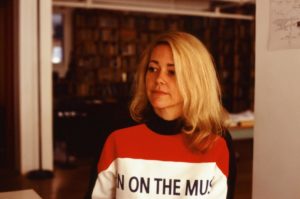
Death of Classical 2022 Review: Watching Birds at the End of the World
Anthony Roth Costanzo & Sae Hashimoto Star in Eye-Opening Work by Aaron Seigel
By Jennifer PyronDeath of Classical and The Green-Wood Cemetery presented the one-night-only world premiere of Aaron Seigel’s “Watching Birds at the End of the World” on July 21, 2022.
This collection of 14 songs, written for countertenor and a vibraphone, illuminates the otherworldly connection of composer Aaron Siegel as a guide for anyone endeavoring a path of greater awareness within. Each song savors a meditative quality that blooms into an atmosphere of emotional imagery, a story, a memory, a calling. Given the performance’s setting, at the Green-Wood Cemetery Catacombs in candlelight, “Watching Birds at the End of the World” invites listeners to value sound as an opening into experiential bliss.
Aaron Siegel wrote “Watching Birds at the End of the World” for countertenor, Anthony Roth Costanzo, and vibraphonist, Sae Hashimoto. Both artists are well-known for consistently demonstrating a purity of process and high caliber technicality in their work and are experiencing vibrant career moments right now. Constanzo’s recent role as Akhnaten at the Met and Hashimoto’s barrier breaking work as a leading percussionist of the ensemble Yarn / Wire, make a highly anticipated collaboration for this debut.
“Watching Birds at the End of the World” reminds us all to embrace life’s mysteries now, before it is too late.
Setting the Tone
Sae Hashimoto’s playful resonance opens the cycle with a gentle breath of pure tone in song No.1, “Sight.” Hashimoto’s motions are like little waves that ease listeners into the quiet power of a hushed mind in preparation for Costanzo’s ethereal voice. Siegel writes with intuitive imagery pertaining to an awareness of all that is, has been, and will be to come. Burgeoning beyond what it means to simply see and crossing over into empathetically responding to what it means to somehow live and die at the same time. This song is a miniature catalog of nostalgic notes carrying the weight of transformation required when processing a vast internal shift.
Song No.2, “Light,” beckons listeners to follow through with this “magical shift, from outside looking in.” Costanzo’s voice takes on an expansiveness that seems to seep into all things at once. One might remember his eyes most in this moment, as he clearly decides to come from some place very intimate and vulnerable within himself. Being in the Catacombs and listening to this moment happen was a historical moment that one might want to relive again and again.
“If for only that moment,
I could see things for real,
That would be enough.”
Song No. 3, “Life,” celebrates the innocent curiosity of growth and reverence for the unknown. Siegel’s lyrics are reminiscent of a riddle in happenstance with the severity of introspection, as one takes a closer examination about what their life’s purpose is and how this purpose will become.
“The vine doesn’t start
on its way with a sense
of the heights that it
finds as it grows.
So, we give it a post
right beside where we plant
and the seed can recall
what it knows.”
Song No. 4, “Ghosts,” appears as a veil of frequencies that Hashimoto skillfully emanates from her vibraphone. Costanzo’s voice engages listeners by telling a story about ghosts in a way that excavates one-by-one the illusive qualities and emotional entanglements of energetic entities compressed as harbored thoughts. Siegel’s lyrics portray a bill of goods bought to be that which we own in our minds that may nag at our hearts and beckon our souls closer in comfort and care. To listen and observe, above all.
Song No. 5, “Distance,” is transformative in the most playful sense with a simple melodic line that uplifts the imagination in unison with Costanzo as he sings about raising our bodies into cloud-filled skies. Hashimoto’s technical precision in this piece is like a swan on the water in which it glides and carries along from an all-knowing place of sound reason and pure delight.
“We should keep walking up
with each foot above the other
no rails to hold on to
or sense of how high.”
Song No. 6, “Truth,” remarks on the weight that truth carries when one honors its vital presence. Its being. In this song, Hashimoto and Costanzo press into the driving vein of Siegel’s work. Almost like jump-starting a heart and measuring its rhythm with a sense of urgency and forwardness. Here, they become triumphant in sharing what life’s mysteries are all about.
“My truth
isn’t a mystery.
It’s right here
in front of me.
In the air,
I can feel it.
It feels me.”
Song No. 7, “Other,” describes ways of living as another that ultimately reveal ways of living as oneself. Siegel’s introspective discoveries are felt in Costanzo’s singing as he goes in and out of emotional solitude, similar to retracting one’s gaze from outside in order to go deeper within. Costanzo’s voice takes on a new palette of expression in this song that may remind some of his unforgettably powerful presence as Akhnaten. He is the ardent master of his craft.
No. 8, “Self,” begins acapella with Costanzo singing about packing an overnight duffel bag. Hashimoto plays in unison with the melody and develops this song into a whimsical way of examining the baggage of self.
“Is it important,” you ask,
“that you do this alone?
That you keep your bag ready
that it stays all your own?”
Song No. 9, “History,” embodies the imagery of waves and foam dissolving the past in order to embrace the new. Hashimoto’s streamlined technique gives a unique balance and fluidity to Costanzo’s buoyant voice in this song. One may feel as though they are riding the ebb and flow of sonic ideas designed to stir and unfurl the mind.
Song No.10, “Song,” is a fleeting reminder of the emptiness felt in an attempt to write a song that makes pain and suffering go away. Siegel’s words turn the listener towards the space in our hearts that cannot be measured and most importantly, never fully explained.
“It would be
a sad song,
resonating in
our bodies.
If I could
write a song
and make it all
go away
it might sound
like this one
but we will never
know for sure.”
Song No.11, “Love” is a lullaby where Hashimoto and Costanzo create a cocoon around the infinite complexities of love. Where is love in the body? Where does it begin? End? How does one explain the change that happens in love? And, is there a way to return the same?
Siegel tracks many trajectories in this song that feel familiar and timeless. The vocal melody is haunting and reverberant.
“There are nodes in my body
where love lives.
Each mass of tissue
a tangle of sensation,
messy like a ball of yarn
with no end to pull on.
To visit these places
is to travel through time
and over geographic space.
And like every journey,
the pathways are uncertain,
and no one returns the same.”
Song No.12, “Hell,” feels chaotic and uncertain. Both Hashimoto and Costanzo tip-toe into explosive moments of distorting chords. ‘Hell’ is a proclamation of breaking away from expectations and diving head first into one’s own grave. One may feel this song is similar to a Samuel Barber composition in how it splashes colors of tonal synthesis between the singular accompanying instrument and the human voice.
“I can play by the rules
as good as anyone and still
enjoy the thrill of going solo
through the sheetrock,
like digging my own grave with a spoon.”
Song No.13, “Loss,” might be the most awe inspiring of this cycle as a whole. In it, Costanzo and Hashimoto create an atmosphere of floating abstractness. They become a purposeful presence. It is a ceremony of relief into the unknown as is breath to the body in the beginning and in the end. One might feel like this song both closes and starts the cycle from this point of departure.
However, Song No.14, ‘Mystery’ is the final piece that commemorates Siegel’s work with a personal touch.
“I used to think
that some time I’d see
all of the great mystery.”



